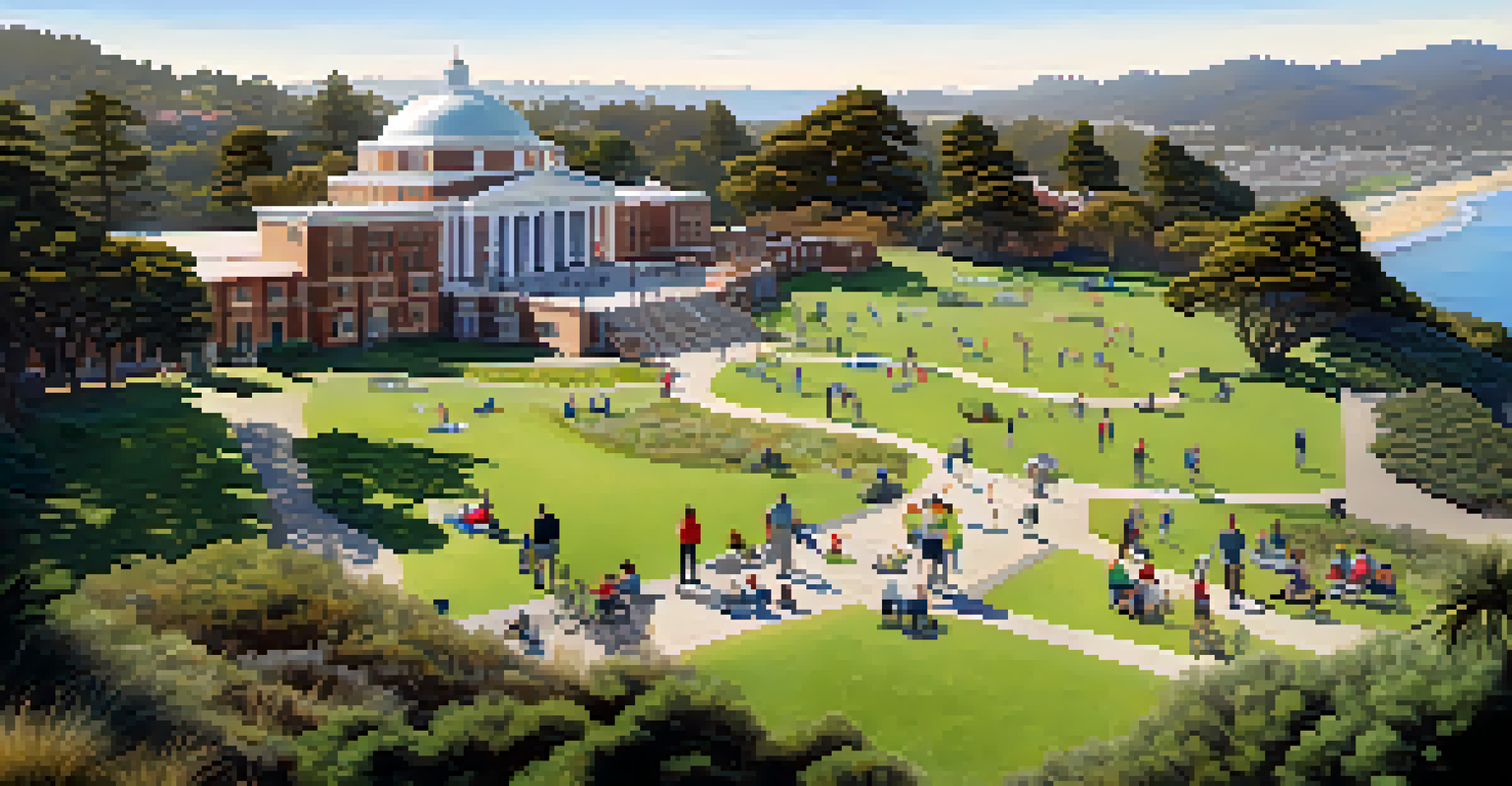The Founding of the Presidio: Military History in SF

The Birth of the Presidio: A Strategic Military Base
The Presidio of San Francisco was established in 1776 by the Spanish, making it one of the oldest military installations in the United States. Its location was chosen for its strategic advantages, providing a commanding view of the Golden Gate and access to the Pacific Ocean. This choice was crucial as it allowed the Spanish to protect their interests along the coastline and secure their territories in the New World.
History is not a burden on the memory but an illumination of the soul.
Initially, the Presidio served as a fort to defend against potential threats from rival European powers, including the British and Russians. Over the years, the site evolved, housing soldiers and their families, and becoming a small community. The presence of military personnel ensured that the region remained under Spanish control, which was vital for trade and exploration.
As the years progressed and California transitioned to Mexican control, the Presidio’s role changed but remained significant. It continued to serve as a military post, adapting to the needs of the new government while maintaining its historical essence. The story of the Presidio reflects the larger narrative of changing power dynamics in the region.
Transition to American Control: The Mexican-American War
The Presidio's fate took a pivotal turn during the Mexican-American War (1846-1848). Following the conflicts, California was ceded to the United States, and the Presidio became a vital part of American military strategy on the West Coast. This transition marked the beginning of a new chapter, as the U.S. government recognized the importance of the site for national defense.

Under American control, the Presidio expanded significantly, with new structures built to accommodate the growing military presence. The U.S. Army utilized the base for various operations, training soldiers, and preparing for conflicts that lay ahead. This period also saw an influx of new technologies and military tactics, which would shape the future of warfare.
Presidio's Strategic Military Role
Established in 1776, the Presidio served as a vital military base, adapting through various historical transitions to protect interests along the Pacific Coast.
The transition was not without challenges; the military had to navigate relationships with local populations and adapt to a rapidly changing political landscape. Nevertheless, the Presidio remained a key asset, symbolizing the United States' growing influence in the Pacific region. Its legacy continued to evolve as it became a cornerstone of military history in San Francisco.
The Role of the Presidio During the Civil War
During the Civil War, the Presidio played a crucial role in the Union’s efforts on the West Coast. It served as a base for troops and a supply depot, helping to maintain order and support Union forces. The strategic location of the Presidio ensured that the U.S. military could monitor potential threats, including Confederate sympathizers in the area.
The past is never dead. It's not even past.
The military presence at the Presidio also fostered a sense of security for the local population during a time of national turmoil. Soldiers stationed there participated in various campaigns, and the base became a vital hub for logistics. This involvement helped shape the military’s identity in the region, as well as its relationship with the local community.
As the Civil War came to a close, the Presidio's significance continued to grow. It transitioned from a wartime base to a peacetime installation, preparing for the challenges of the future. The experiences gained during this tumultuous period would leave a lasting impact on the military operations conducted from the Presidio.
World War I and the Presidio: A Military Powerhouse
The onset of World War I saw the Presidio evolve into a critical military powerhouse. The base was instrumental in training soldiers and preparing them for the challenges of a global conflict. With the U.S. joining the war in 1917, the Presidio became a focal point for mobilization and support operations.
New facilities were constructed, and the base expanded to accommodate the influx of troops and resources. The military community at the Presidio played a significant role in supporting the war effort, with many soldiers being deployed to battlefields overseas. This period marked a transformation in the base's operations, with a heightened focus on readiness and efficiency.
Transition to a National Park
After being closed as a military installation in 1994, the Presidio was transformed into a national park, preserving its rich history while promoting community engagement.
After the war, the Presidio continued to serve as a training ground, adapting to the changing landscape of military needs. The lessons learned during World War I would influence future strategies and operations, solidifying the Presidio's place in military history. Its legacy as a training hub continued to grow, fostering a strong sense of camaraderie among service members.
The Presidio's Role in World War II
World War II brought renewed significance to the Presidio as a strategic military installation. It served as a command center for the Western Defense Command and was pivotal in coordinating military efforts on the Pacific front. The Presidio's location allowed for effective communication and logistical support, making it an essential asset during the war.
The base saw the arrival of thousands of troops, who were trained and prepared for deployment in various theaters of war. The Presidio also hosted important military conferences, further solidifying its role as a key player in the U.S. war effort. This influx of personnel and activity transformed the Presidio into a bustling center of military operations.
As the war progressed, the Presidio adapted to the changing needs of the military, expanding its facilities and resources. The experiences gained during this time shaped the future of military strategy and operations. The legacy of the Presidio during World War II remains a testament to its importance in American military history.
Post-War Era: Transitioning to a New Role
After World War II, the Presidio faced a new challenge as the military began to downsize. The Cold War era brought about a shift in military strategies and the need for a different type of military presence. The base transitioned from a wartime installation to a peacetime facility, focusing on training and support rather than direct combat.
This shift allowed the Presidio to explore new initiatives, including community engagement and environmental preservation. The military recognized the importance of building positive relationships with local communities, leading to initiatives that promoted cooperation and understanding. This approach reflected a broader trend in military operations during the post-war years.
Legacy of Military Training
Throughout its history, the Presidio evolved into a key training hub for U.S. military forces, significantly impacting military operations from World War I through the Cold War.
In 1994, the Presidio was officially closed as an active military base, marking the end of an era. However, this transition paved the way for the site’s transformation into a national park, preserving its rich history while making it accessible to the public. Today, the Presidio stands as a unique blend of military legacy and natural beauty, inviting visitors to explore its past.
The Presidio Today: A Living Legacy
Today, the Presidio serves as a vibrant national park, showcasing its historical significance while offering recreational opportunities. Visitors can explore the stunning landscapes, hike scenic trails, and learn about the rich military history through engaging exhibits. The transformation from a military base to a public park reflects a commitment to preserving history while promoting community engagement.
The Presidio also hosts various cultural events and programs, fostering a sense of connection between the past and present. This living legacy allows visitors to appreciate the historical importance of the site while enjoying the natural beauty of the area. It serves as a reminder of the diverse stories that have shaped San Francisco and the broader military narrative.

As we reflect on the founding of the Presidio, it becomes clear that its history is intertwined with the growth of the nation. From its establishment as a Spanish fort to its evolution into a national park, the Presidio stands as a testament to resilience and adaptation. Its legacy continues to inspire future generations, reminding us of the power of history in shaping our communities.